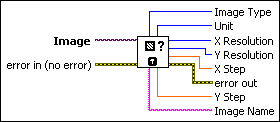IMAQ GetImageInfo VI
Owning Palette: Image ManagementInstalled With: NI Vision Development ModuleGives different characteristics of the image.









 |
Image is a reference to the source image. |
||||||||||||||||||||||||||
 |
error in (no error) describes the error status before this VI or function runs. The default is no error. If an error occurred before this VI or function runs, the VI or function passes the error in value to error out. This VI or function runs normally only if no error occurred before this VI or function runs. If an error occurs while this VI or function runs, it runs normally and sets its own error status in error out. Use the Simple Error Handler or General Error Handler VIs to display the description of the error code. Use error in and error out to check errors and to specify execution order by wiring error out from one node to error in of the next node.
|
||||||||||||||||||||||||||
 |
Image Type specifies the type of the image. Choose from the following values:
|
||||||||||||||||||||||||||
 |
Unit is the measuring unit associated with the image. Choose from the following values:
|
||||||||||||||||||||||||||
 |
X Resolution specifies the horizontal resolution of the image. |
||||||||||||||||||||||||||
 |
Y Resolution specifies the vertical resolution of the image. |
||||||||||||||||||||||||||
 |
X Step specifies the horizontal distance separating two adjacent pixels in the specified Unit. |
||||||||||||||||||||||||||
 |
error out contains error information. If error in indicates that an error occurred before this VI or function ran, error out contains the same error information. Otherwise, it describes the error status that this VI or function produces. Right-click the error out indicator on the front panel and select Explain Error from the shortcut menu for more information about the error.
|
||||||||||||||||||||||||||
 |
Y Step specifies the vertical distance separating two adjacent pixels in the specified Unit. |
||||||||||||||||||||||||||
 |
Image Name is the name of the image. |



